
Maker Faire 2011-19
Originally uploaded by Inkyhack
Not sure it was the "World's Largest Waffle Cone" but I do like how the size is a selling point.
Devoted to photos of teriyaki donut shops, taco trucks, great food, unusual or interesting foods, and any other commercial enterprise or cultural phenomenon that is just darned interesting to see.

Not sure it was the "World's Largest Waffle Cone" but I do like how the size is a selling point.

My daughter got a foot-long sausage from this stand and said it was actually very good, despite the name.


Food historian Ken Albala, University of the Pacific in Stockton, California, demonstrated how to make pasta from raw wheat (including how to grind it into flour) as well as how to make pasta sauce using only tomatoes, olive oil and locally-grown spices. This was part of Sustainability month. The food was delicious and certainly reminded everyone in the audience on how plastic most of our "pre-prepared food" tastes these days.

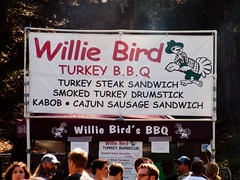
In all seriousness: if you want to learn about an amazing chapter in American food history, research the role that turkey has placed in American cuisine. Up until the 1950s, turkey was a rarity. It was only served as an elite item during the Thanksgiving holiday.
Then a few things happened - the frozen food industry was discovered (TV dinners) and they found that turkey was the easiest meat to freeze for long-term storage; and the turkey industry moved West to California, where the climate was perfect for turkey breeding year-round. That meant that turkey could be supplied to store shelves any time of the year, not just during that one time of the year when the turkeys fattened up.
The turkey industry also unified and started a national campaign to get turkey in our diet. Turkey sandwiches and turkey lunch meats started to appear. In fact, the campaign was so pervasive, that the remake of "A Christmas Carol" made in the late '50s (the great version staring Alison Sims), the ending was changed. Scrooge no longer asked for the biggest "goose" in the window, as the original book states, but instead asks for the biggest "turkey." Turkey, of course, was completely foreign to English folks at the time of the novel (1843), but the mention in the film in the 1950s went largely unnoticed, thanks to the great turkey marketing campaign. This would, of course, help further propagate (in a very Orwellian manner imho) that turkey not only was a "traditional" meal for Christmas, but "always was a traditional meal" for Christmas.
Then, when American started to become health concious in the early 90's, more was done. Turkey was sold as the "healthy meat" due to its naturally low-fat content. Turkey hot dogs and turkey pepperoni appeared, along with other turkey substitutes.
Today, it's not unusual for us to have turkey bacon, turkey sausage, and even turkey chili all in the same day without thinking twice about it. And this food stand - found at the 2010 Hardley Strictly Bluegrass Festival - further demonstrates how far the turkey industry has gone in the past 60 years.
But seriously, there's a lot more to the story. I urge all food-o-philes and marketing students to do the research.

Sorry, but I can't help it: isn't that a sex move that's illegal in Arkansas?
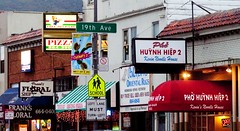
Just a random shot in San Francisco. I like the SE Asian Noodle House being just two doors down from a traditional Italian pizza place. No big revelations here, except that I love the choices available, thanks to multiculturalism.
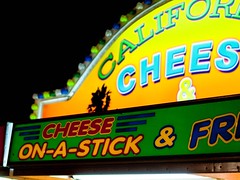
I didn't try it. I was afraid it had been deep-fried in butter-flavored lard.
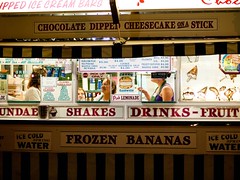
Ah, Chocolate Dipped Cheesecake on a Stick. I'll have a coronary bypass with that, please.

Here's the great thing about the multicultural aspect of the American culture - you can discover all these wonderful foods. Pho is one of my latest obsessions. It was introduced to me by the Hmong administrative assistant at my job.
Pho, for those who don't know (it's pronounced "fa," not "foe" though most Asians will forgive the mispronunciation), is a Vietnamese rice-noodle soup that has a bunch of vegetables, a mix of seafood, chicken and beef and often is served very spicy.
It's also very popular in California. There are Pho restaurants popping up in just about every city in the state, as the soup has been adopted as the official soup of the "hipster," the official youth movement of California.
This photo was taken from inside a Pho Restaurant in San Francisco that was recommended by a friend of mine.

Here's one of the small problems with multiculturalism - a word that might be perfectly acceptable in one culture takes on a completely different meaning somewhere else. Take this restaurant - Ho's. Thanks to the mass-marketed shallow rap culture that is shoved down our throats by the mega media entertainment corporations, the word Ho has taken on a whole new meaning in modern American culture.
I wonder if anyone has explained this to the restaurant's owners?

Another great example of the multi-culturalism of San Francisco - an Italian Restaurant next door to a Sushi Bar.
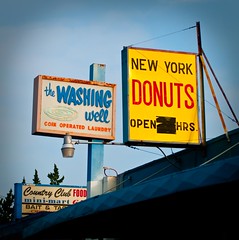
Can someone please explain to me how a New York Donut is different from any other donut?

This is one of two "soul food" restaurants I have come across lately. I'm not a food expert, but it's my understanding that "soul food" is actually a modification of the "slave food" that used to be served to African-Americans - lots of fried foods, pork, collard greens, beans and rice. I know there have been a number of African-American activists who have recently protested the glorification of Soul Food, claiming it's terribly unhealthy for folks, including an entire episode of "The Boondocks" where grandpa opens a "Soul Food" restaurant and most of his customers develop extreme obesity and heart problems.
What strikes me is this place is a combination of "soul food" and "BBQ," which traditionally is seen as southern white folks food, the very folks who forced this unhealthy food on the slaves in the first place.
It's just a notion that passed by when I first discovered this place.
By the way, the locals say the food at this restaurant is very good.

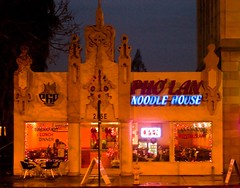
I found this place in downtown San Jose. Not sure if the Pho is any good as I didn't get a chance to try it, but what struck me was the "Breakfast, Lunch, Dinner" sign on the window.
Pho for breakfast? Is that like having pizza for breakfast? I'm not knocking it, just curious.
For those who don't know, Pho is a Vietnamese soup with rice noodles that tends to be very spicy. I love it and have a friend who makes it from scratch for me on my birthday.
But for breakfast?

This was taken at a reception for college students who did volunteer work in other countries last year. At the reception, they served a hodge-podge of foods from those countries. This is deep-fried bannanas from South America (Brazil, I do believe).
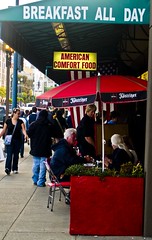
Yup, a restaurant with a little honesty - American Comfort Food - Breakfast All Day. Woohoo! Gimme a half pound of bacon on top of my Captain Crunch please!

Taco Truck in San Franisco that advertises Argentinian food.
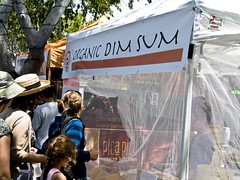
Maker Faire 2009, San Mateo California. Only in California.
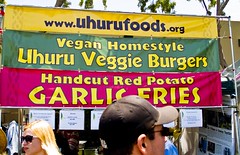
Maker Faire 2009, San Mateo California. Only in California.

Maker Faire 2009, San Mateo California. Only in California.

Cinnamon Almonds. There are many flavors of almonds, obviously. But why aren't their flavored walnuts or pecans?
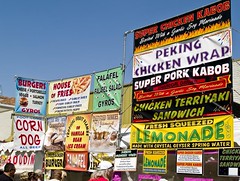
Chicken Teriyaki sandwich, "Super" chicken kabob, Peking "chicken wrap," and the "House of Fries." Do the gastronomic wonders never cease to end.
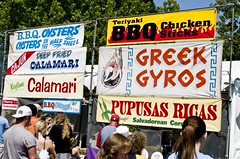
Teriyaki Barbecue chicken, Greek Gyros and Salvadorean Corn, all at the same booth. And next door to two different types of calamari and barbecued oysters.

The Super Burrito, because a regular burrito just isn't big enough. Plus, a mango on a stick.
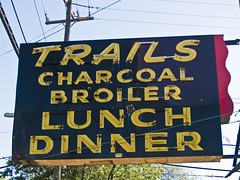
Restaurant in Sacramento, California.

Sacramento, California. The restaurant is open from 6 a.m. to 3 p.m. every day.
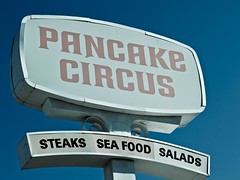
Sacramento, California. I wonder if they have steak-flavored pancakes?
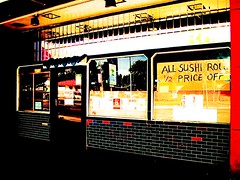
Japanese/Chinese/American cuisine in Sacramento, California